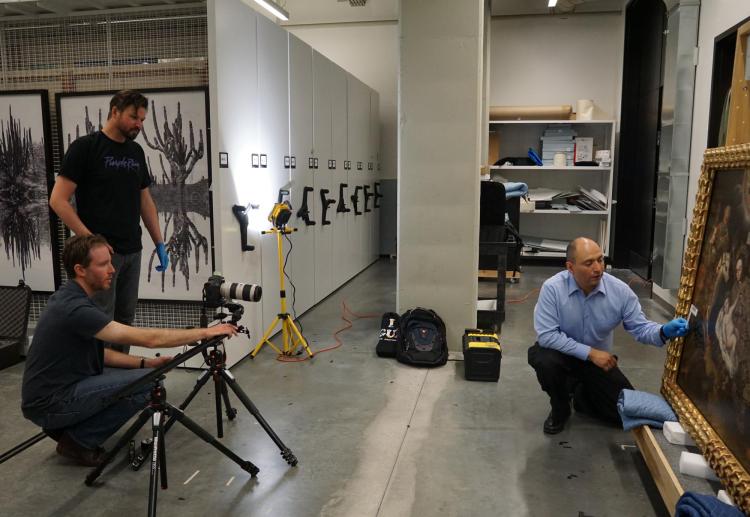Anthropologist launches high-tech study of color in ancient art
Project involves innovative collaboration between CU Art Museum, non-invasive spectroscopy and a CU Boulder expert in antiquity
It’s easy enough to marvel at a tapestry of color in your local museum, but University of Colorado Boulder students are getting a first-hand look at human history that only an ultra-close examination of color can provide.

Students and Gerardo Gutiérrez perform technical photography of Spanish colonial painting on loan from the Denver Art Museum to the CU Art Museum. Photo by Mariana Lujan Sanders. At the top of the page, Gutiérrez performs elemental analysis of pigments with X-ray fluorescence (XRF) of Spanish colonial painting on loan from the Denver Art Museum to the CU Art Museum. Photo by James Cordova.
The graduate and undergraduate students are working with Gerardo Gutiérrez, an anthropology professor who specializes in archaeology, and the Colors of History Project at CU Boulder. Together, they are bringing advanced atomic spectrometry methods to the CU Art Museum, where students in archaeology and art and art history are learning to use the equipment and process the data.
The project brings cutting-edge analysis to ancient pieces of art that are seldom analyzed this way, and it is an unusual collaboration that sheds light on ancient peoples.
“We are studying ancient societies through their use of colors,” said Gutiérrez. “Their preferences in what pigments they choose in their paintings create meaning by codifying the color as a language. We do not use color by accident. We use color to share complex ideas.”
How those pigments were manufactured tell an increasingly illuminating story about the cultures that produced them. But until fairly recently, the methods to specifically identify the materials selected in creating pigments and dyes were destructive and performed only in large laboratory facilities. As such, only a limited number of art and archaeological pieces have ever been studied because these objects rarely leave the museums and typically cannot be sampled given their incommensurable historical value.
This project, though, uses an array of high-tech, non-invasive methods, including hyperspectral and multispectral imaging, fiber optic reflectance, Raman and Fourier transform infrared spectroscopy, and XRF (X-ray fluorescence) spectrometry.
Each method produces distinct pieces of information on the chemical composition of ancient pigments and dyes. For instance, infrared spectrometry identifies different molecules by the way they vibrate in that light spectrum.
For Pre-Columbian artifacts, infrared spectrometry helps identify Maya Blue pigment, which represents an important step forward in ancient color technology. Artists began combining blue dye extracted from indigo plants with a specific type of clay, creating one of the most durable colors humanity has ever developed. Maya Blue is now considered a technological feat in the chemistry and physics of nanoparticles.
By using X-ray spectrometry and Infrared spectroscopy (which reveal chemical composition of matter through analysis of which parts of the electromagnetic spectrum , Gutierrez and his students can identify the primary elemental composition, trace elements and chemical compounds of the materials that were used in the creation of pigments. They have also been developing a color palette containing swaths of pure pigments and dyes, especially those recognized as frequently used by ancient cultures.
They compare the “spectral signatures” (indicating chemical composition) of known colors with those under study and identify unknown colors. The identification of ancient pigments and dyes helps scientists and historians to understand exactly where and how pigments were produced, what trade existed to secure the pigments, and even what ideological value was place on colors by these earlier populations.
We are studying ancient societies through their use of colors. ... Their preferences in what pigments they choose in their paintings create meaning by codifying the color as a language. We do not use color by accident. We use color to share complex ideas.”
For instance, both Aztec and Mayan cultures shared a common method of depicting living-thing representations, like humans and animals. In both groups, animated figures were depicted with black charcoal shapes; however, they were also outlined with an amazing red organic lake color produced from female cochineal insects.
“They did that only for humans and animal figures and not for numbers or calendrical symbols, which are instead painted with a mineral red ocher,” Gutiérrez said. “What that suggests is that the painters are, in a way, providing a soul and animating human and animal figures in their ancient documents.”
Funding to begin this initiative came from the National Science Foundation. The color laboratory originally focused on Pre-Columbian Art, but now is expanding into Spanish Colonial paintings of Latin America, Classical Mediterranean, Northern European, Asian and African Art.
Gutierrez and his team have been analyzing art and archaeological objects residing in the CU Art Museum, Olmec rock art found in Mexico, and, by collaborating with Professor James Cordova from the Department of Art and Art History, Spanish Colonial Paintings that were recently lent to CU by the Denver Art Museum.
“There are few places in the U.S. that are focusing on the analysis of ancient pigments and dyes, such as the Getty Conservation Institution, the Los Angeles County Museum and now the University of Colorado Boulder,” Gutiérrez said.
The initiative is supported by the dean of arts and sciences and the vice chancellor of research. The program counts on the interdisciplinary assistance of CU Professors Steve Lekson, James Cordova, Herbert H. Covert, Douglas Bamforth and Sarah James; the curators and staff of the CU Art Museum Sandra Q. Firmin, Maggie Mazzullo, Hope Clark Saska, Brittney Scholnick, and Pedro Caceres; and graduate students Mariana Sanders, Erik Jurado, Tom Hanson, and Devin Pettigrew, with “special thanks” to Diana Wilson, office manager of the Department of Anthropology.

